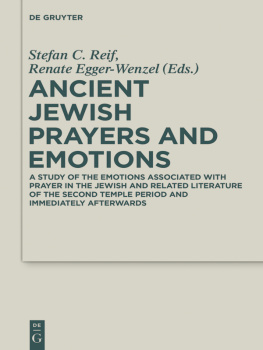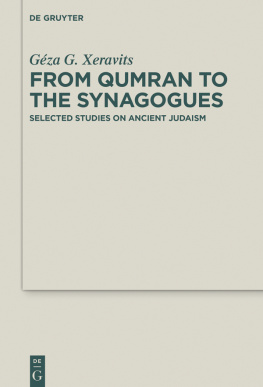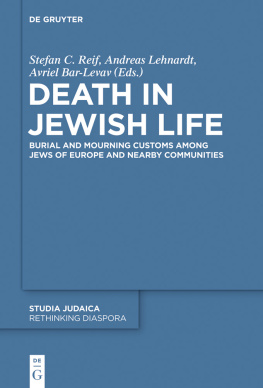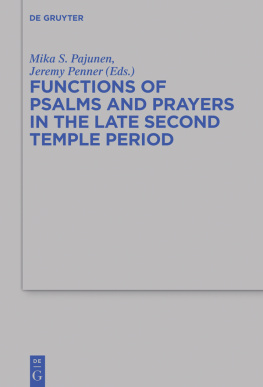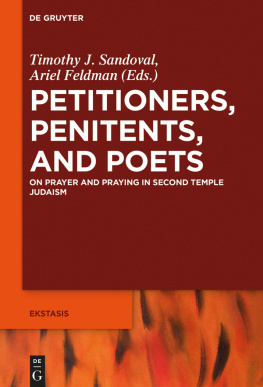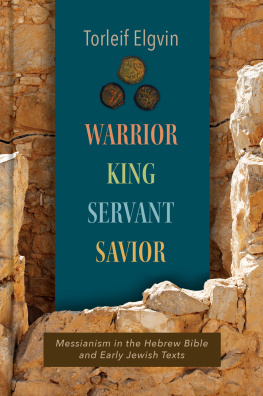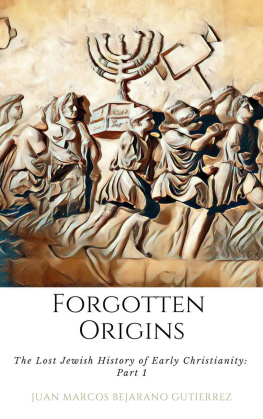- Stefan C. Reif
The Place of Prayer in Early Judaism - Christine Abart
Moments of Joy and Lasting Happiness - Kristin De Troyer
Sounding Trumpets with Loud Shouts Emotional Responses to Temple Building: Ezra and Esdras - Simone M. Paganini
Adjusting the Narrative Emotions and the Prayer of Moses (Jub 1:1921) - Thomas R. Elner
Emotions in Jerusalems Prayer: Baruch and Lamentations - Beate Ego
Prayer and Emotion in the Septuagint of Esther - Michael W. Duggan
1 Maccabees: Emotions of Life and Death in Narrative and Lament - Friedrich V. Reiterer
Praying to God Passionately: Notes on the Emotions in 2 Maccabees - Nria Calduch-Benages
Emotions in the Prayer of Sir 22:2723:6 - Markus Witte
Emotions in the Prayers of the Wisdom of Solomon - Barbara Schmitz
Judith and Holofernes: An Analysis of the Emotions in the Killing Scene (Jdt 12:1013:9) - Renate Egger-Wenzel
Sarahs Grief to Death (Tob 3:717) - Dalia Marx
The Prayer of Susanna (Daniel 13) - Jonathan Ben-Dov
Language, Prayer and Prophecy: 1 Enoch, the Dead Sea Scrolls and 1 Corinthians - Moshe Lavee
From Emotions to Legislation: Asenaths Prayer and Rabbinic Literature - Ursula Schattner-Rieser
Emotions and Expressions of Emotion as a Didactic Guide as to How to Pray: B e rakhot in the Aramaic Prayers of Qumran - Angela Kim Harkins
A Phenomenological Study of Penitential Elements and Their Strategic Arousal of Emotion in the Qumran Hodayot (1QH a cols. 1[?]-8) - Asaf Gayer
The Centrality of Prayer and Stability of Trust. An Analysis of the Hymn of the Maskil in 1QS IX, 25b-XI, 15a - Oda Wischmeyer
Prayer and Emotion in Mark 14:32-42 and Related Texts - Eve-Marie Becker
and the Concept of Emotional Prayer in Earliest Christianity: Rom 8:15 and Acts 7:60 in Their Context(s)
Ancient Jewish Prayers and Emotions
Deuterocanonical and
Cognate Literature Studies
__
Edited by
Friedrich V. Reiterer, Beate Ego and Tobias Nicklas
Volume 26

ISBN 978-3-11-037429-2
e-ISBN (PDF) 978-3-11-036908-3
e-ISBN (EPUB) 978-3-11-038608-0
ISSN 1865-1666
Library of Congress Cataloging-in-Publication Data
A CIP catalog record for this book has been applied for at the Library of Congress.
Bibliografische Information der Deutschen Nationalbibliothek
The Deutsche Nationalbibliothek lists this publication in the Deutschen Nationalbibliografie;
detailed bibliographic data are available on the Internet at http://dnb.dnb.de .
2015 Walter de Gruyter GmbH, Berlin/Boston
www.degruyter.com
Ancient Jewish Prayers and Emotions
Papers Delivered at a Conference Arranged by the ISDCL and the University of Haifa, in Haifa, 25 February, 2014
Preface
The papers published in this volume were delivered at an international conference jointly sponsored by the International Society for the Study of Deuterocanonical and Cognate Literature (= ISDCL), Salzburg, Austria, and the University of Haifa, Israel, which was also kindly supported by the Archbishop Emeritus of Salzburg, Dr Alois M. Kothgasser, SDB, by the publishing house Walter de Gruyter of Berlin, Germany, and by the 1965 Trust of London, England, through the good offices of Dr Vivienne Cohen. The notion of having one of its smaller conferences in Israel was discussed by some participants at the ISDCL conference in Palermo in 2011 and the subsequent arrangements for the event were made by Professor Renate Egger-Wenzel, President of the ISDCL, by its Treasurer, Dr Christine Abart, by Professor Stefan Reif of St Johns College in the University of Cambridge, England, and by Dr Jonathan Ben-Dov of the University of Haifa.
The conference, which was formally opened by Professor Zohar Segev, chair of the department of Bible and Jewish History at the University of Haifa, took place from the 25 February 2014 and its ten sessions were attended by an average of about thirty-five participants, including the lecturers. There was a tour of the University of Haifa, a visit to its Hecht Museum, and a festive dinner on the last evening. In addition, the fortieth anniversary of the establishment of the Genizah Research Unit at Cambridge University Library headed by Stefan Reif was marked by a special evening at which greetings were conveyed by Professor Michal Yerushalmi, Vice-President of Research at the University of Haifa, and remarks about the Unit were made by a panel chaired by Dr Moshe Lavee, joint head of the Interdisciplinary Center for the Broader Application of Genizah Research at the University of Haifa. The panel consisted of Professor Efraim Lev, joint head of the Interdisciplinary Center, Professor Mordechai Friedman of Tel Aviv University, Dr Ben Outhwaite, current head of the Cambridge Unit, and Professor Reif, Fellow of St Johns College.
It is very gratifying that all but four of the papers given at the conference have been submitted to the editors for inclusion in this volume. Professor Reiterer was prevented at the last minute by a family illness from travelling to Israel to give his paper but has kindly provided it here for publication. The chosen topic of the conference, and now of this volume, has been covered in a variety of ways. Many parts of the Hebrew, Aramaic and Greek literature of the Second Temple period, with its numerous constituent and varied genres, have received attention and the methodologies chosen by the contributors have demonstrated a wide range of scholarly approaches. Eleven countries were represented at the conference and the fresh ideas offered to the participants, and now to the readers of this volume, should not only be of current interest but also point the way for future research in many related (and often neglected) areas of study. The organizers of the conference and the editors of the volume are grateful to all those who have taken part in the project, or sponsored it, and acknowledge, with thanks, the important work done on the volume by Mrs Waltraud Winkler, and the role of the publishers for accepting it for publication and seeing it safely and efficiently through the press.
Stefan C. Reif and Renate Egger-Wenzel (editors)
Contents
Stefan C. Reif
Christine Abart
Kristin De Troyer
Simone M. Paganini
Thomas R. Elner
Beate Ego
Michael W. Duggan
Friedrich V. Reiterer
Nria Calduch-Benages
Markus Witte
Barbara Schmitz
Renate Egger-Wenzel
Dalia Marx
Jonathan Ben-Dov
Moshe Lavee
Ursula Schattner-Rieser
Angela Kim Harkins
Asaf Gayer
Oda Wischmeyer
Eve-Marie Becker
Stefan C. Reif
The Place of Prayer in Early Judaism
1 Introduction
It is a pleasure and privilege to open this collection of essays by attempting to set them in the historical context of the ancient past, as well as preparing some of the ground for the building of the new critical theories of the present and the future. In that respect, my function here is akin to that of the Roman god Janus. As is well known, Janus was the god of beginnings and ends, as well as of time, and he is usually represented as having two faces, one looking backwards to the past and the other forwards to the future. How then is it best to approach this somewhat daunting and challenging task? Given the title of this paper, and indeed the overall subject of the current volume, it is clear that the broad theme that requires attention is the theory and practice of prayer as they developed within the overall history of the Jews in the period that led up to the rise of Christianity and Rabbinic Judaism. I first propose to assess the degree to which the past 120 years have witnessed methodological change and innovative analysis and to allude to the role played by the discoveries from the Cairo Genizah in such scholarly developments. I shall then offer some remarks about the controversial nature of historical analysis in the treatment of Jewish liturgical evolution and point to the bibliographical studies that can now help us in our research in this field. It will also, of course, be necessary to mention the extent to which we, who specialize in the subject being discussed, are indebted to the scholars of the Dead Sea Scrolls for the materials and the interpretations that they have made available to us, as indeed to the founders and leaders of the International Society for Deuterocanonical and Cognate Literature for the conferences and publications that they have so successfully sponsored in the past thirteen years. Moving from the past to the present and the future, I shall make reference to the newest themes and the way forward for scholarship at least in in the short term. If by that point I have achieved my stated objective, readers will then be better equipped to read and absorb the important studies that are included in the body of this volume.
Next page
